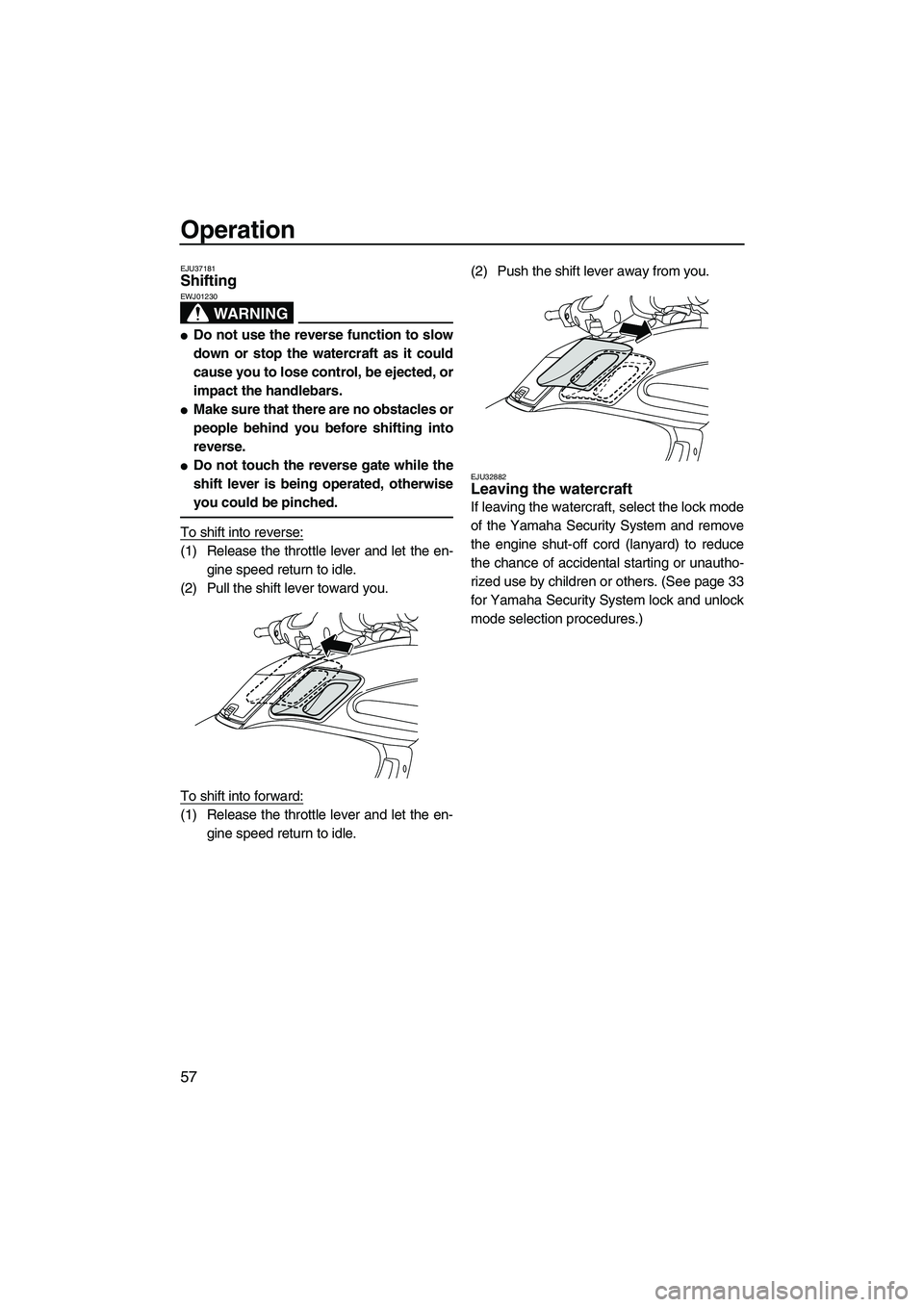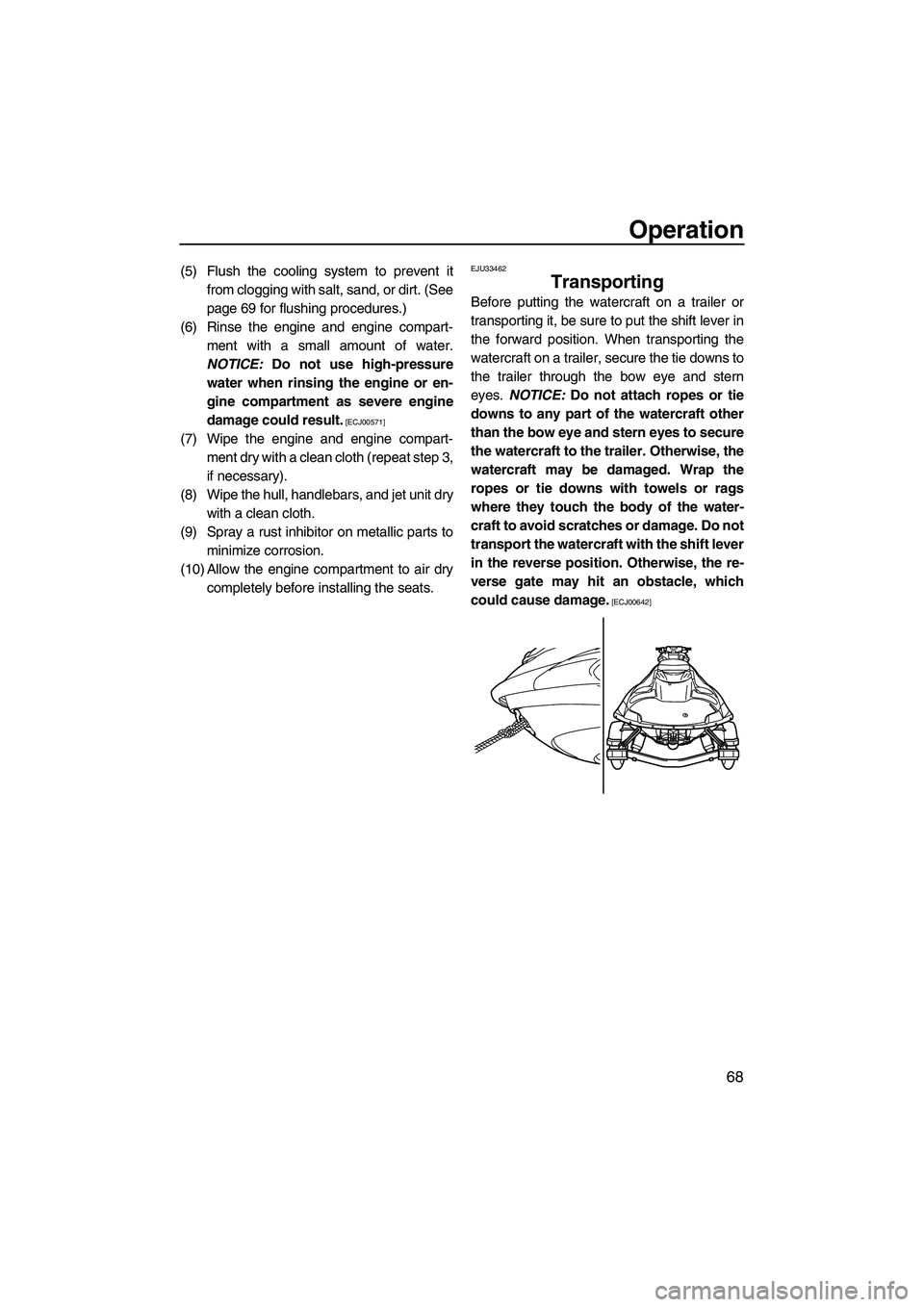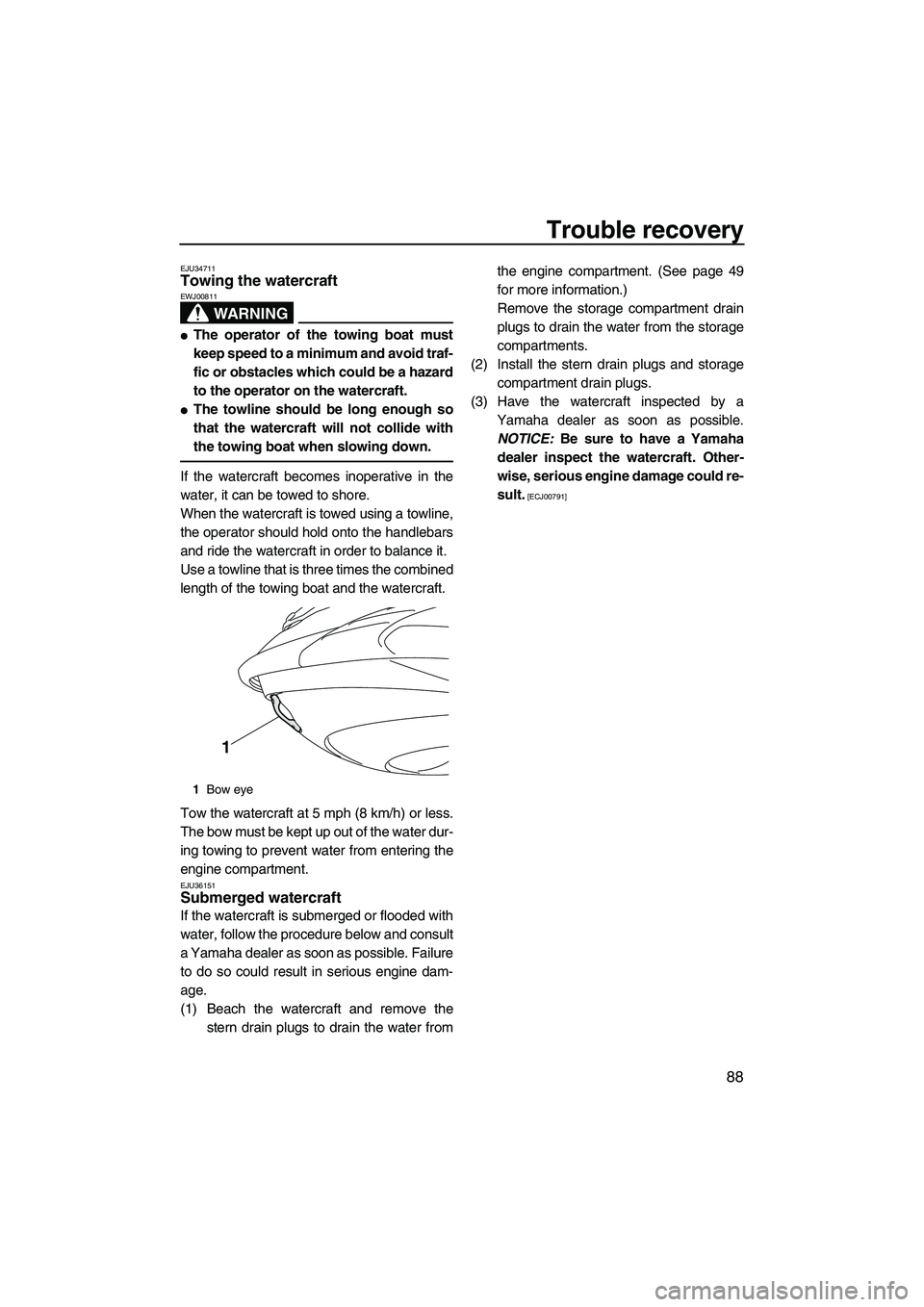Page 64 of 98

Operation
57
EJU37181Shifting
WARNING
EWJ01230
�Do not use the reverse function to slow
down or stop the watercraft as it could
cause you to lose control, be ejected, or
impact the handlebars.
�Make sure that there are no obstacles or
people behind you before shifting into
reverse.
�Do not touch the reverse gate while the
shift lever is being operated, otherwise
you could be pinched.
To shift into reverse:
(1) Release the throttle lever and let the en-
gine speed return to idle.
(2) Pull the shift lever toward you.
To shift into forward:
(1) Release the throttle lever and let the en-
gine speed return to idle.(2) Push the shift lever away from you.
EJU32882Leaving the watercraft
If leaving the watercraft, select the lock mode
of the Yamaha Security System and remove
the engine shut-off cord (lanyard) to reduce
the chance of accidental starting or unautho-
rized use by children or others. (See page 33
for Yamaha Security System lock and unlock
mode selection procedures.)
UF2C70E0.book Page 57 Monday, November 3, 2008 10:16 AM
Page 71 of 98
![YAMAHA FZS 2009 Owners Manual Operation
64
which can result in severe damage.
[ECJ00541]
(3) Start the engine and operate the water-
craft as straight as possible and above
planing speed for at least 2 minutes to
discharge any wat YAMAHA FZS 2009 Owners Manual Operation
64
which can result in severe damage.
[ECJ00541]
(3) Start the engine and operate the water-
craft as straight as possible and above
planing speed for at least 2 minutes to
discharge any wat](/manual-img/51/50223/w960_50223-70.png)
Operation
64
which can result in severe damage.
[ECJ00541]
(3) Start the engine and operate the water-
craft as straight as possible and above
planing speed for at least 2 minutes to
discharge any water remaining in the en-
gine compartment. (If the engine does
not start, see “Towing the watercraft” on
page 88 or “Submerged watercraft” on
page 88.) NOTICE: Do not operate the
engine at full throttle for at least 1
minute after the engine has been re-
started. Excessive water in the engine
compartment can splash into the en-
gine, which can result in severe dam-
age.
[ECJ00551]
EJU33251
Turning the watercraft
WARNING
EWJ00770
�Do not release the throttle lever when
trying to steer away from objects—youneed throttle to steer. A collision could
result in severe injury or death.
�When operating at higher speeds, make
gradual turns or slow down before turn-
ing. Sharp high-speed turns may cause
the watercraft to slide sideways or spin,
throwing the operator and passengers
overboard, which could cause an injury.
Steering control depends on the combination
of handlebar position and the amount of throt-
tle.
Water sucked in through the intake grate is
pressurized by the impeller in the jet pump. As
the pressurized water is expelled from the
pump through the jet thrust nozzle, it creates
thrust to move and steer the watercraft. The
higher the engine speed, the more thrust pro-
duced.
The amount of jet thrust, in addition to the po-
sition of the handlebars, determines how
sharply you turn.
A. More throttle produces higher thrust, so
the watercraft will turn more sharply.
UF2C70E0.book Page 64 Monday, November 3, 2008 10:16 AM
Page 75 of 98

Operation
68
(5) Flush the cooling system to prevent it
from clogging with salt, sand, or dirt. (See
page 69 for flushing procedures.)
(6) Rinse the engine and engine compart-
ment with a small amount of water.
NOTICE: Do not use high-pressure
water when rinsing the engine or en-
gine compartment as severe engine
damage could result.
[ECJ00571]
(7) Wipe the engine and engine compart-
ment dry with a clean cloth (repeat step 3,
if necessary).
(8) Wipe the hull, handlebars, and jet unit dry
with a clean cloth.
(9) Spray a rust inhibitor on metallic parts to
minimize corrosion.
(10) Allow the engine compartment to air dry
completely before installing the seats.
EJU33462
Transporting
Before putting the watercraft on a trailer or
transporting it, be sure to put the shift lever in
the forward position. When transporting the
watercraft on a trailer, secure the tie downs to
the trailer through the bow eye and stern
eyes. NOTICE: Do not attach ropes or tie
downs to any part of the watercraft other
than the bow eye and stern eyes to secure
the watercraft to the trailer. Otherwise, the
watercraft may be damaged. Wrap the
ropes or tie downs with towels or rags
where they touch the body of the water-
craft to avoid scratches or damage. Do not
transport the watercraft with the shift lever
in the reverse position. Otherwise, the re-
verse gate may hit an obstacle, which
could cause damage.
[ECJ00642]
UF2C70E0.book Page 68 Monday, November 3, 2008 10:16 AM
Page 95 of 98

Trouble recovery
88
EJU34711Towing the watercraft
WARNING
EWJ00811
�The operator of the towing boat must
keep speed to a minimum and avoid traf-
fic or obstacles which could be a hazard
to the operator on the watercraft.
�The towline should be long enough so
that the watercraft will not collide with
the towing boat when slowing down.
If the watercraft becomes inoperative in the
water, it can be towed to shore.
When the watercraft is towed using a towline,
the operator should hold onto the handlebars
and ride the watercraft in order to balance it.
Use a towline that is three times the combined
length of the towing boat and the watercraft.
Tow the watercraft at 5 mph (8 km/h) or less.
The bow must be kept up out of the water dur-
ing towing to prevent water from entering the
engine compartment.
EJU36151Submerged watercraft
If the watercraft is submerged or flooded with
water, follow the procedure below and consult
a Yamaha dealer as soon as possible. Failure
to do so could result in serious engine dam-
age.
(1) Beach the watercraft and remove the
stern drain plugs to drain the water fromthe engine compartment. (See page 49
for more information.)
Remove the storage compartment drain
plugs to drain the water from the storage
compartments.
(2) Install the stern drain plugs and storage
compartment drain plugs.
(3) Have the watercraft inspected by a
Yamaha dealer as soon as possible.
NOTICE: Be sure to have a Yamaha
dealer inspect the watercraft. Other-
wise, serious engine damage could re-
sult.
[ECJ00791]
1Bow eye
1
UF2C70E0.book Page 88 Monday, November 3, 2008 10:16 AM